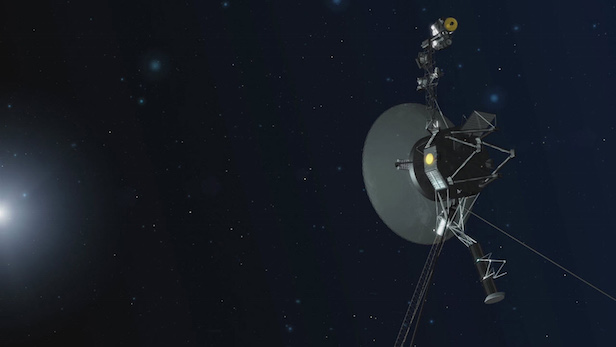Voyager 1 fires up its thrusters for the first time in almost 40 years
NASA’s farthest and fastest spacecraft is the only human-made object that has reached beyond the comfort of our Solar System

The Voyager 1 spacecraft has been long travelling through the cosmos for 40 years. Image credit: NASA/JPL-Caltech
In the same way you worry that you’re car won’t start after years of it sitting in the garage, engineers were delighted to conduct a successful attempt of using a set of thrusters on Voyager 1 that have been unused for 37 years. The spacecraft’s team had to use a different set of thrusters due to the unfortunate degrading of the spacecraft’s original thrusters.
Voyager 1 is NASA’s farthest and fastest spacecraft, as it the only human-made object that has reached beyond the comfort of our Solar System and delved into interstellar space, the environment between stars. At the time of writing, Voyager 1 has reached a distance of 140 times the distance of Earth from the Sun, travelling at an estimated velocity of 38,000 miles per hour (61,200 kilometres per hour). Within this 40-year journey, the spacecraft has had to keep its antenna continuously pointed at Earth for communication purposes.
To maintain the position of the antenna, the spacecraft uses a series of small devices that produce small pulses, or “puffs”, lasting only milliseconds, called thrusters. Since 2014, the engineers at NASA have noticed that the thrusters responsible for orientating Voyager 1, dubbed “attitude control thrusters”, have gradually declined in efficiency. They noticed that the thrusters required more puffs to give off the same amount of energy. This is why the Voyager team have now shifted to a set of four backup thrusters, previously used in 1980.
“With these thrusters that are still functional after 37 years without use, we will be able to extend the life of the Voyager 1 spacecraft by two to three years,” says Suzanne Dodd, project manager for Voyager at NASA’s Jet Propulsion Laboratory (JPL), Pasadena, California.
To solve this problem, the Voyager recruited a group of propulsion experts from JPL to analyse the problem. The group consisted of Chris Jones, Robert Shotwell, Carl Guernsey and Todd Barber, and they studied all appropriate options and predicted how the spacecraft would react to these scenarios. The chosen solution was to give the job of orientation to a set of thrusters that have been dormant for 37 years.

The last planet Voyager 1 visited on its journey was Saturn in November 1980. Image credit: NASA/JPL
“The Voyager flight team dug up decades-old data and examined the software that was coded in an outdated assembler language, to make sure we could safely test the thrusters,” says Jones, chief engineer at JPL.
Within its planetary exploration days, Voyager 1 flew past the gas giants Jupiter and Saturn and some of their important moons. In order to fly by these targets and position it’s instruments accordingly, the “trajectory correction manoeuvre”, or TCM, thrusters were utilised. The TCM thrusters are identical in size and functionality to the attitude control thrusters, which are located on the backside of the spacecraft. Before Voyager 1’s last flyby of Saturn on 8 November 1980, the TCM thrusters were used in a more continuous firing mode, but never used in the brief bursts that could appropriately orient the spacecraft.
The popular manufacturer, Aerojet Rocketdyne, developed all of Voyager 1’s thrusters. These thrusters, called the MR-103, were also placed onboard other NASA spacecrafts, such as Cassini and Dawn.
On 28 November 2017, the Voyager team tested the four TCM thrusters for the first time in 37 years by conducting 10-millisecond pulses. Due to the vast distance between Voyager 1 and us, the scientists had to eagerly wait 19 hours and 35 minutes for Voyager 1’s results to reach the antenna at NASA’s Deep Space Network in Goldstone, California, United States. When the message was finally received on 29 November 2017, scientists were ecstatic to find that the tests were not only successful, but they worked just as well as the attitude control thrusters.
“The Voyager team got more excited each time with each milestone in the thruster test. The mood was one of relief, joy and incredulity after witnessing these well-rested thrusters pick up the baton as if no time had passed at all,” says Barber, a JPL propulsion engineer.
Going forward, the Voyager 1 team plan to make to the switch to the TCM thrusters in January. To make this change, the spacecraft will have to start up one heater per thruster. Unfortunately, this requires power, and power is already a scarce resource on an already old mission. So when there is no more power to use these heaters, the team will then switch back to the declining attitude control thrusters.
Keep up to date with the latest reviews in All About Space – available every month for just £4.99. Alternatively you can subscribe here and make the most of our Christmas offer for a fraction of the price!




